Local History
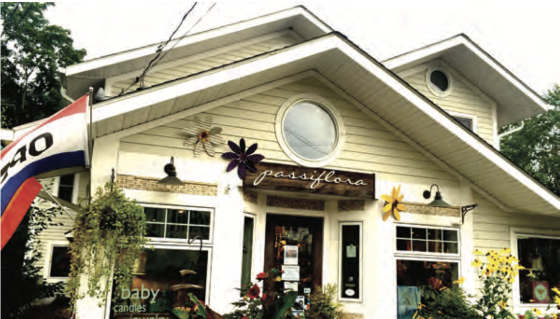
Passiflora Pentimento
-by the Hillsdale Historians
In November 2020 we wrote about the history of the Hillsdale Post Office in Post Office Pentimento. In painting, pentimento is defined as earlier images that have been changed or painted over and are no longer visible to the naked eye but still exist, under the surface, like ghosts.
Buildings also have these hidden elements and we are always on the lookout for clues in old photographs. Over the past two centuries many structures in Hillsdale have been added to, renovated, or reconfigured for modern use, yet retain elements of their original selves.
One of the buildings in the center of town – specifically 2638 St. Rt. 23 – is home to Passiflora, the unique gift shop opened in 2009 by Ken Davis and Kevin Draves. We were curious because someone recently sent us an undated photograph of a building in the same location that appears strikingly different from the building that is there today. We wondered if it is even the same building.
We started digging around old newspaper coverage, and deeds from the county clerk’s office (available online). Then we sought out some of Hillsdale’s lifelong residents for their recollections. Eventually, we began to piece the story together.
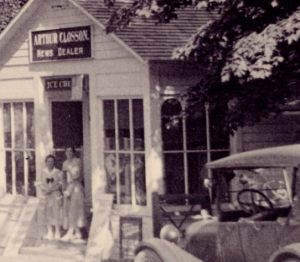
Arthur also sold ice cream, as you can in the photo, which made the store a swell hangout for kids like the two schoolgirls posing at the door.
Around 1920, Arthur Closson uprooted the icehouse from his family’s farm and set it down next to the Hillsdale House. (By 1920, electric refrigeration was becoming widespread, making icehouses obsolete.) Arthur opened a small shop which can be seen in the picture below. It was today what would be called a newsstand and sold newspapers, stationery, and candy. Arthur also acquired a supply of “popular fiction” — novels he would rent out for five cents per week.
Arthur was also listed as the “local reporter” for the Hillsdale Harbinger, which he sold in his shop. (Today, we might question the possible conflict of interest: the more sensational the news, the papers are bought and the more the news dealer makes. But having spent many hours perusing the pages of the Harbinger, we can attest there was never anything sensational in that paper – ever.) Arthur died in 1922 at the age of 40. His widow, Lila, took over his local reporter role for the Harbinger.
Lila sold the store to J. D. “Johnny” Quick, who owned and operated it for about 40 years. Johnny added a butcher case to his store. It is said that Will Mallery, who had owned a foundry near the rail depot, would dispatch his dog, Jack, to Johnny’s store alone to fetch and return (uneaten) a pound of hamburger for Will’s dinner. That’s not the only trick Jack could perform.
We have had some difficulty sorting out what happened in the store in the 1950s and 1960s, but we have uncovered some clues, if not a solution.
We know that at some point, Johnny Quick’s store closed. We also know that in 1970, the Berkshire Eagle published an obituary of Edward Navin.
It says that he and his wife ran the Village Square? Did they buy it from Lila Quick? Did they name it the Village Square? We can’t say.

Will Mallery and Jack, balancing on Will’s foot while wearing a hat and clenching a pipe in his teeth. Who’s a good boy? (Photo: Lynne Colclough)
But in 1967, this classified advertisement (bottom of the page) ran in the Eagle.
Based on the timing suggested in the Navin obituary (“Until his retirement “a few years ago”) we surmise that the Navins placed this ad.
We also know that Stuart and Marion Keough bought the Village Square because we know when they sold it. Is it possible that the Keoughs responded to the ad in 1967, or perhaps later? We don’t know.
What we do know is that the Keoughs sold the Village Square to Jerry and Jeanne Chiavelli in 1974. They owned it for just a year, and in 1975, Lyle and Louise Hatch bought the store. They then proceeded to provide Hillsdale with some drama we think of as the Great Coffee Cup Controversy.
In 1975, Mr. Hatch erected a huge Coffee Cup sign on what is now Cullin Park. He claimed that it doubled his business. The town cited him for a zoning violation. What ensued was a major battle with Mr. Hatch claiming the town was harassing him and the town claiming that he had erected his sign on town property, the aforementioned Cullin Park.
Opinion in town was mixed: Some thought he was encroaching on town property and defacing the Civil War monument. Others thought he should be able to advertise his business.
Hatch pointed out that his deed extended to Rt. 23 and that the State Highway Department had elongated Cullin Park by 50 feet two years earlier with neither permission nor compensation.
As these things will, the matter went to court and in 1977, Town Justice Raymond Edwards ruled that the sign was not illegal. was not on public property, and did not deface the Civil War Memorial. The town vowed to appeal but the matter was rendered moot when Mr. and Mrs. Hatch sold The Village Square to Anna Salenovich in 1979 and the sign came down.
Ms. Salenovich apparently ran The Village Square free of controversy and in 1985, she sold out to Diane Shadic. Ms. Shadic operated the store until 1987, when she sold it to Peg and Brian Farratto. Ms. Shadic was gracious enough to purchase an ad in the Roe Jan Independent thanking her customers and wishing the new owners success.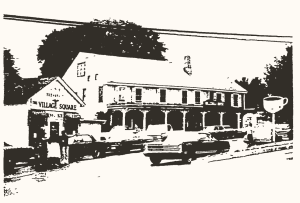
The Ferratto purchase was notable for two reasons. First, the couple changed the name of the restaurant. The Village Square would now be known as Marguerite’s at The Village Square. (Marguerite was Peg Ferratto’s full given name.)
The second reason was that the Ferrattos, who ran Marguerites for three years, were the first owners to sell to a real estate investor instead of a restaurateur. Edward Fanter bought the building and after Marguerite’s decamped, leased the space to John and Tina Anderson, who opened Partners Restaurant. Partner’s was open until 1993, and that year, Hui “George” Chen opened the Main Moon Chinese restaurant, bringing Asian cuisine to Hillsdale for the first time.
Main Moon operated for several years before closing around 1998, and for a number of years, the building sat empty. Then, in 2004, it was purchased from Edward Fanter by an architect named Julius Traina, who promptly transferred the title to an entity he owned called Yodi LLC. Traina Architectural Associates undertook a major renovation that transformed the old icehouse into the building that Passiflora occupies now. Mr. Traina passed away in 2008, but according to the Hillsdale tax rolls, Yodi LLC still owns the building to this day.
As we noted in our Post Office post, towns change, buildings are built, and businesses open and close in them. But you don’t have to look far to find bits of the past, like pentimenti, still present in the space between old and new.

The Historians of Hillsdale are grateful for the assistance provided by Scott and Regina Cooper, Lynne and Jim Colclough, Sally and Bob Hopkins and Craig Norton. Follow the Hillsdale Historians and see their latest blog posts as well as past stories by signing up here.
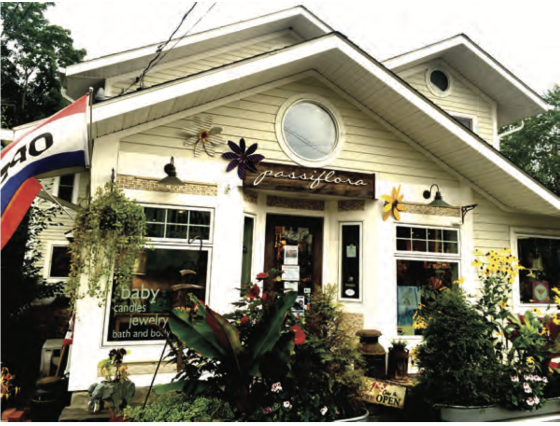

1967 classified advertisement.
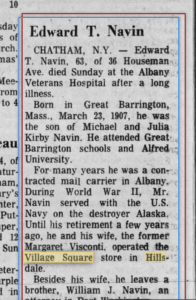
obituary of Edward Navin.
